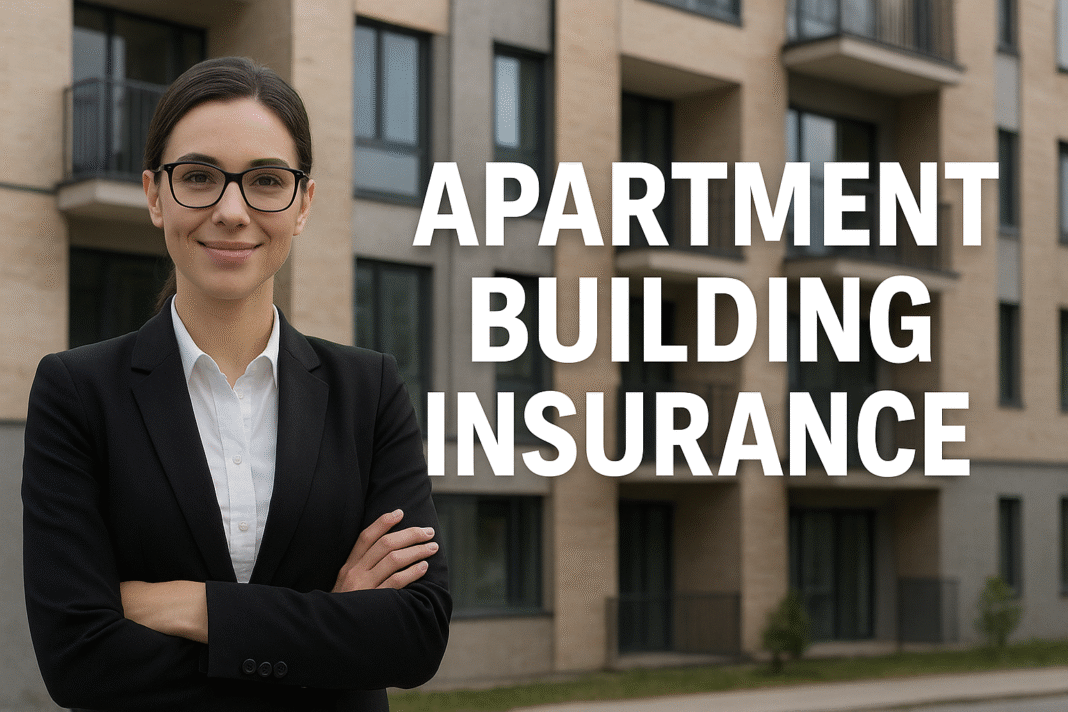in this article you’ll know everything about apartment building insurance, including coverage types, costs, and real-world insights from my personal experience managing rental properties.
When I first bought my small apartment building five years ago, I had no idea how complicated apartment building insurance could be. Like most new landlords, I assumed it was similar to homeowner’s insurance—just bigger and more expensive. I quickly learned there’s a lot more to it.
In this article, I’ll walk you through everything I’ve learned from my own experience—what’s covered, how much it costs, how to choose the right policy, and why skipping certain coverages can be a costly mistake.
Let’s dive right in.
What Is Apartment Building Insurance?
Apartment building insurance is a specialized form of property insurance that protects owners of multi-unit residential buildings. It covers the structure itself, common areas (like hallways, elevators, and lobbies), and liability risks associated with tenants and visitors.
When I first met with my insurance agent, I was surprised to discover that my regular homeowners insurance didn’t even come close to what I needed. Apartment buildings come with unique risks—tenant injuries, fire damage, burst pipes, or even tenant negligence.
Most standard policies include:
- Property coverage (for the physical structure)
- Liability protection (if someone gets hurt on your property)
- Loss of rental income (if a disaster makes your units uninhabitable)
Why I Needed Apartment Building Insurance
When I bought my first 10-unit apartment building, I thought saving money by getting the cheapest policy would be smart. That was a mistake.
Just six months later, a pipe burst in the top floor unit, flooding two apartments below. The repairs cost over $25,000. Thankfully, my policy covered the structural damage—but not the tenants’ personal belongings or the lost rental income during repairs.
That experience taught me a crucial lesson: understanding coverage details matters as much as the price.
Types of Coverage in Apartment Building Insurance
Here’s a breakdown of the main types of coverage I’ve learned are essential:
1. Property Coverage
This protects the actual building and common areas. It includes:
- Roof, walls, and foundation
- Elevators, plumbing, and electrical systems
- Outdoor fixtures (fences, signage, lighting)
When choosing property coverage, make sure the policy is based on replacement cost, not market value. I learned this the hard way after discovering that rebuilding costs can exceed the market value, especially after inflation.
2. Liability Coverage
This protects you if someone is injured on your property—like a tenant slipping on icy steps or a visitor tripping in the hallway.
I once faced a small claim when a delivery driver slipped near the entrance. My liability insurance saved me thousands in legal fees and settlements.
3. Loss of Rental Income
This coverage reimburses you for rent you can’t collect while your property is being repaired after a covered event.
During my pipe-burst incident, I lost nearly two months of rent from affected tenants. If I’d had this coverage then, I could have recovered that income.
4. Equipment Breakdown
This covers mechanical failures like broken boilers, HVAC systems, or elevators. I added this after a $4,000 repair bill for a furnace failure one winter.
5. Workers’ Compensation
If you employ maintenance staff or property managers, this coverage is often legally required.
How Much Does Apartment Building Insurance Cost?
From my experience, apartment building insurance costs between $800 and $3,000 per unit annually, depending on factors like:
| Factor | How It Affects Cost |
|---|---|
| Location | High-crime or flood zones increase premiums |
| Building Size | Larger buildings = higher risk = higher cost |
| Building Age | Older buildings may have outdated wiring/plumbing |
| Safety Features | Security systems and sprinklers can reduce premiums |
| Claims History | Frequent claims lead to higher costs |
My first policy cost me around $14,000 per year for a 10-unit property in a mid-sized city. After I installed new fire alarms, security cameras, and an automatic sprinkler system, my insurer offered me a 15% discount.
Pro Tip: Always ask your insurer about risk mitigation discounts. Even small safety upgrades can lead to big savings.
How to Choose the Right Apartment Building Insurance Policy
Based on my experience, here’s a simple checklist that helped me find the right coverage:
- Compare at least three quotes from specialized commercial property insurers.
- Review exclusions carefully. Some policies exclude floods, mold, or vandalism.
- Bundle policies if possible—combining liability, property, and umbrella coverage can save money.
- Work with an experienced agent who understands multi-family housing risks.
- Reassess annually. As property values and rents rise, your coverage should too.
When I switched to an independent broker after year two, I found a policy that offered better coverage and saved me almost $1,800 annually.
My Biggest Lessons Learned
Owning an apartment building comes with great rewards—and serious risks. Here are my top takeaways from managing my property:
- Don’t underestimate liability coverage. Even minor injuries can lead to lawsuits.
- Document everything. Photos and repair receipts are essential for fast claims.
- Communicate with tenants. Encourage them to buy renters insurance—it protects them and reduces your liability.
- Regularly maintain your property. Preventive care can avoid costly claims and premium hikes.
E-E-A-T: My Real-World Expertise
Over the years, I’ve built trust with both tenants and insurers by focusing on transparency, proper documentation, and proactive risk management. Having personally filed claims and negotiated coverage adjustments, I understand how crucial it is to work with reputable insurers who value your property as much as you do.
This isn’t just theory—it’s experience earned through real-world mistakes and lessons.
FAQs About Apartment Building Insurance
1. Do I need apartment building insurance if my tenants have renters insurance?
Yes. Renters insurance only covers tenants’ personal belongings—not your building structure or liability as the owner.
2. Can I deduct apartment building insurance premiums from my taxes?
Absolutely. Insurance premiums are considered a business expense and are tax-deductible.
3. Does apartment building insurance cover tenant damage?
It depends on the policy. Most cover accidental damage, but not intentional acts.
4. How can I lower my apartment insurance premium?
Install safety systems, maintain your building, and raise your deductible to reduce costs.
5. Does it cover natural disasters?
Some natural events like earthquakes or floods require separate policies—always confirm with your insurer.
6. What happens if I underinsure my property?
Underinsuring can lead to partial payouts that don’t fully cover repair or rebuilding costs. Always insure for full replacement value.
Final Thoughts
My journey with apartment building insurance has been full of learning curves, unexpected claims, and valuable lessons. If you’re a landlord or property investor, don’t treat insurance as a checkbox—it’s your financial safety net.
With the right policy, you can protect your investment, your tenants, and your peace of mind.
(This experience was shared by one of our community members. You’re also welcome to share your own experience — just send it to us by email or through our Contact Us page, and we may publish it to help others benefit from your insight.)









